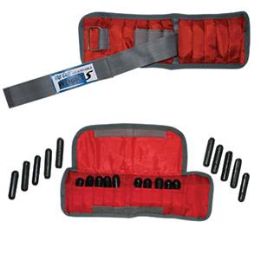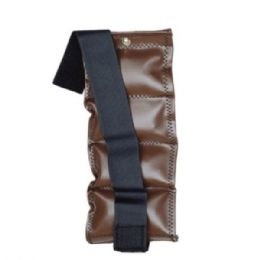
Wrist and ankle cuff weights are used as a way of adding leverage resistance to the arms and legs in exercise workouts. Hands can remain free as the wrist cuff doesn’t need to be held in a grip, and the ankle cuff is not attached to any major muscle and therefore can be used in almost any exercise.











How Are Wrist/Ankle Weights Used?
Wrist and ankle cuff weights are weights that are strapped around the wrists and ankles, and are generally filled with steel shot or sand, usually weighing between one to ten pounds. They are used similarly as other weight-workout devices such as dumbbells except users don’t have to hold onto the weight with their hands while working out. To wear wrist/ankle cuff weights, users will either slip their hands/feet into a donut shaped weight, or wrap the weights around their wrist/ankle and tighten them with a strap or a Velcro band.
The added weight to the wrist or ankle offers enhanced leverage resistance to the movement of the arms and legs, increasing the workout activity. Wrist/ankle weights can make workouts more intense, and their ease and convenience of use make them excellent tools for building body muscles and strength.
Benefits of Using Wrist/Ankle Weights
Wrist/ankle weights can provide a good workout for your muscles when performing even simple movements such as kicking, walking, jumping, using a jump rope or shadow boxing because a person doesn’t have to hold the weights with the hands. Wrist/ankle weights allow individuals to move their arms and legs freely, providing good resistance and creating a more effective workout.
Using Cuff Weights for Exercise and Fitness
Wrist weights for cardio training workouts – A cardio workout is a physical exercise of varying intensity that raises the heart rate and increases the oxygen intake to adequately meet the demands of the workout, creating a stronger cardiovascular system that will deliver more oxygen to the cells in the muscles, strengthening the muscles while also burning off fat.
When using wrist/ankle weights for a cardio workout, the user should use lighter weights that securely fasten around the wrists or ankles, but they should not be strapped on too tightly to feel uncomfortable. The user can walk, jog or do other exercises such as shadow boxing with the cuff weights. When the arms feel tired, simply take the weights off the arms and continue to exercise without them. Once the user becomes acclimated to the weight of the cuffs and they do not make the user feel tired, heavier cuff weights can then be implemented to help strengthen the upper and lower body and burn more calories.
Wrist cuff weights can also be used for strength training to help increase the size and tone of the biceps, triceps and shoulders. The cuff weights don’t have to be heavy because of the repetitions to be used during the training session. The American Council on Exercise recommends using cuff weights within the 1 – 3 pound range for most people.
Biceps – After the cuff weights are strapped onto the wrist, be sure to pump the arms intensely while jogging, walking, or running. During breaks while jogging, stand with arms outstretched on each side with the palms up and bend the elbows, drawing the hands in toward the shoulders.
Triceps – With using the cuff weights, you are increasing the resistance and helping to build muscle at a faster pace. When jogging, for example, pumping the arms during the run will work out the triceps. During a jogging break, reach both arms high above the head, and then bend the arms at the elbow until the hands are behind the head, and then extend the arms until they are straight back over the head, as this will benefit the triceps muscles.
Shoulders – When jogging with cuff wrist weights, the shoulder muscles receive exercise benefit from the back-and-forth movement of the arms. For an enhanced shoulder workout, when standing still allow the arms to hang straight down at the sides. Using only the shoulder muscles, raise the arms until they are sticking straight out, parallel with the ground. Repeat this until tired.
Ankle cuff weights also offer resistance workouts, leading to one of the best ways to improve not only the leg muscles each time the legs are raised up, but the overall strength of the core muscles, as well.
Versatility – Ankle cuff weights offer versatility to workouts by helping to enhance different leg exercises by offering resistance to the same leg movements. Repeating the workout movements the same way over and over again will cause the body to adapt to the movements, leading to less beneficial results. For example, if the user tends to work the leg muscles, try using leg cuff weights to do the same type of exercise but in different positions. Leg cuff-weight exercises can be done while seated, standing, lying on the back or stomach, or kneeling on the hands and knees. Ankle cuff weights can also be helpful when walking or running but be careful, according to a study by the University of Kentucky. Wearing ankle weights while walking or jogging can place too much stress on the ankle, knee and hip joints, and can throw off the spinal alignment.
Shaping and toning of the legs - When done properly, adding cuff ankle weights to lower body workouts can give the legs better shape and tone without looking like the legs of a bulky body builder. Using the resistance of added ankle weights, doing leg raises can help leg muscles grow stronger with more lean muscle mass. As an added benefit, it is known that muscle burns more calories than fat, even when at rest, so stronger leg muscles will help boost metabolism and help with weight management.
Water workouts – Some ankle weights are designed to be used in water as well as for dry land workouts. Ankle cuff weights can add enhanced resistance for the legs while swimming or doing other water exercises, and ankle weights used underwater tend not to damage the joints or stress the legs with the overall impact as they might on dry land.
Ankle cuff weights also help strengthen other muscles besides the leg muscles. A person can strap on ankle weights before doing a set of pull-ups and other weight-bearing upper body exercises, therefore strengthening the upper-body muscles more than they normally would without the ankle cuff weights.
Ankle cuff weights can also help with abdominal workouts, especially for targeting the lower abdominal section. For beneficial results, wear ankle weights when doing bicycle exercise, knee-to-chest exercises, and reverse abdominal lifts. When using ankle weights with abdominal workouts, it helps to keep the abdominal muscles contracted while maintaining a pelvic tilt during the exercise routine. Remember when using ankle weights to keep the workout movements slow and steady. Sudden jerks or moving too quickly may cause back injuries.
Suggested Weight of Wrist/Ankle Weights
The American Council on Exercise suggests using cuff weights that are within the 1 – 3 pounds range. By keeping within this weight range, the user is less likely to develop injuries to the muscles and joints. If a person is an accomplished bodybuilder and if three pounds isn’t enough weight, with their experience they can safely use a higher weight. But, for most people, staying within the 1 – 3 pound weight range is a safe way to build up muscle strength, stamina and tone, and enhance cardio workouts.
Rehabmart is pleased to offer a comprehensive selection of superior quality cuff weights from our outstanding vendors that include Fabrication Enterprises, North Coast, Sammons Preston, Graham Field, J/Fit, Southpaw Enterprises, Independence Medical, Pivotal 5, Clinton Industries and Hausmann Industries.
Hulet Smith, OT
Rehabmart Co-Founder & CEO
ws